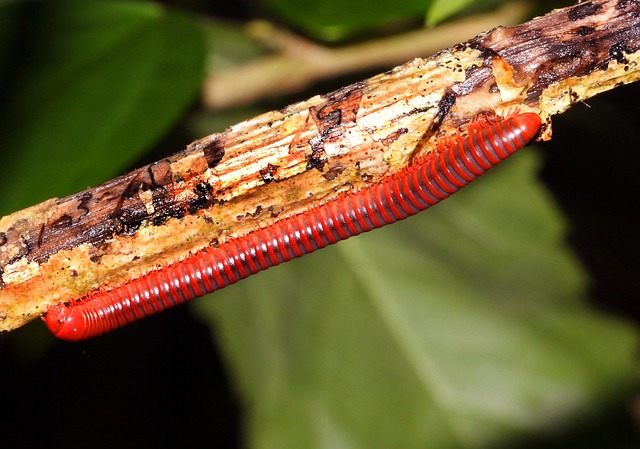Millipedes can be managed naturally through understanding their preference for moist, dark environments and organic matter. Eco-friendly solutions like neem oil, diatomaceous earth, or essential oils are safe alternatives to toxic chemicals, preserving biodiversity and the ecosystem. Deterring millipedes involves reducing moisture, removing organic debris, sealing entry points, regular cleaning, and using eco-friendly products; creating an inhospitable environment for them over time.
Millipedes, though unwelcome intruders, can be managed without breaking the bank. This guide explores affordable and reliable eco-friendly millipede control solutions, empowering homeowners to tackle these creepy crawlers effectively. We demystify their behavior and habitat, highlighting the benefits of natural methods over harsh chemicals. Discover practical tips for prevention and maintenance, offering long-term relief from these multi-legged invaders without compromising the environment. Embrace eco-friendly millipede solutions for a pest-free home and peace of mind.
Understanding Millipedes: Behavior and Habitat
Millipedes are fascinating yet often unwelcome visitors to our homes and gardens. Understanding their behavior and habitat is key to implementing effective, eco-friendly millipede solutions. These creatures prefer moist environments and are commonly found in areas with high organic matter content, such as under rocks, logs, or leaf litter. They move slowly and tend to avoid light, making them more active at night or during damp conditions.
Knowing their preferred habitats allows us to take proactive measures to prevent infestations. This includes reducing moisture levels in affected areas, removing sources of organic debris, and sealing entry points. Eco-friendly solutions like using neem oil, diatomaceous earth, or essential oils can also be effective in deterring millipedes without causing harm to people or pets. These methods not only control populations but also maintain a balanced ecosystem.
The Benefits of Eco-Friendly Control Methods
Many traditional pest control methods rely on toxic chemicals that can be harmful to both humans and the environment. This is why opting for eco-friendly millipede solutions has become increasingly popular among homeowners and businesses alike. These methods not only minimize ecological impact but also offer a safer alternative for your family, pets, and local wildlife.
By choosing eco-friendly options, you contribute to preserving biodiversity and promoting a healthier ecosystem. Natural repellents, organic pesticides, and biological control agents are effective in managing millipede populations without leaving behind harmful residues. This approach respects nature’s balance while providing reliable and long-lasting solutions for your millipede concerns.
Practical and Cost-Effective Solutions for Homeowners
Millipedes might be tiny, but they can cause a big problem for homeowners, especially those who prefer an eco-friendly approach to pest control. But don’t worry, there are practical and cost-effective solutions available that keep your home millipede-free without resorting to harsh chemicals.
One of the simplest and most natural ways to deter millipedes is by maintaining a clean and dry environment. These pests are attracted to moisture and organic matter, so regular cleaning, especially in areas with high humidity like bathrooms and kitchens, can significantly reduce their presence. Using eco-friendly cleaning products and fixing any leaks or water sources they might be attracted to will create an inhospitable environment for millipedes. Additionally, sealing entry points and gaps around pipes, doors, and windows can prevent them from invading your space.
Prevention and Maintenance Tips for Long-Term Relief
Millipedes are known for their resilience, so preventing an infestation requires a multi-faceted approach. Regular maintenance is key to long-term relief. Start by sealing entry points around your home—millipedes often invade through cracks and crevices. Check for any gaps in doors, windows, or foundations, and use caulk or weather stripping to close them off. Since millipedes are attracted to moisture, maintaining a dry environment is essential. Ensure proper drainage around your property and fix any leaks in your home, especially in basements and crawl spaces. Regularly cleaning and vacuuming can also help eliminate these insects, as can removing decaying plant matter and compost from your yard.
For eco-friendly millipede solutions, consider using natural deterrents like diatomaceous earth or neem oil, which are safe for both people and pets. These substances disrupt the millipedes’ exoskeletons, leading to dehydration and death. Another effective strategy is implementing good housekeeping practices, such as promptly wiping up spills and avoiding leaving food out in open containers. By combining these prevention and maintenance tips, you can create an inhospitable environment for millipedes, reducing their presence over time without resorting to harsh chemicals.
Millipedes may be relentless invaders, but with an understanding of their behavior and a commitment to sustainable practices, homeowners can effectively manage these pests without breaking the bank. Eco-friendly millipede solutions, such as sealing entry points, maintaining proper humidity, and employing natural repellents, offer reliable and long-lasting relief. By combining practical strategies from our comprehensive guide, you can reclaim your space from these multi-legged intruders, ensuring a comfortable and pest-free home environment.
